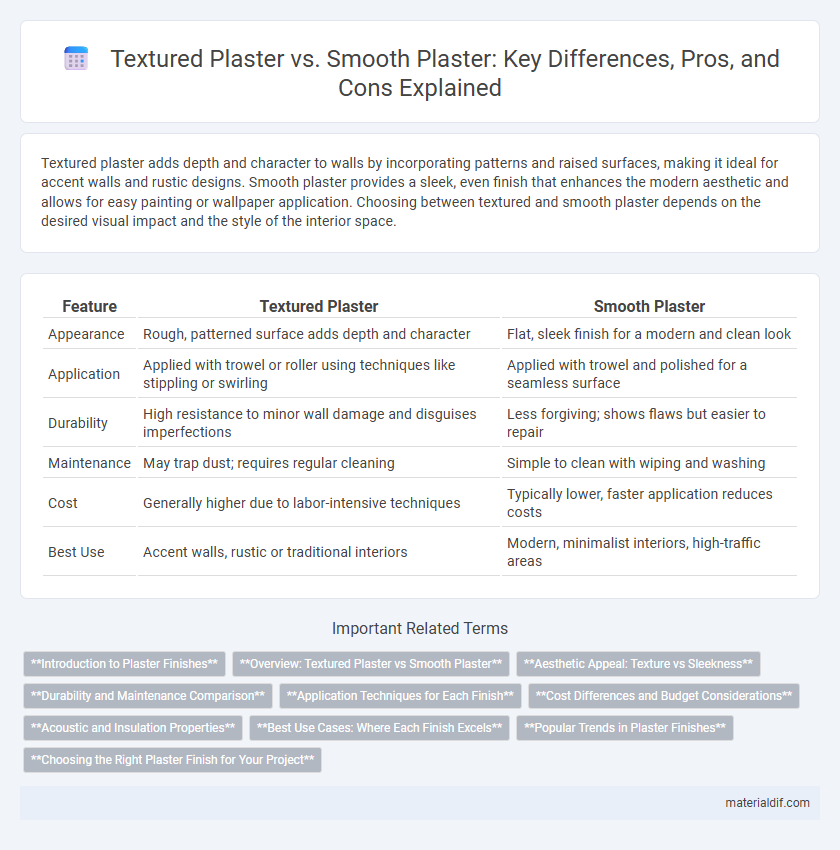Textured plaster adds depth and character to walls by incorporating patterns and raised surfaces, making it ideal for accent walls and rustic designs. Smooth plaster provides a sleek, even finish that enhances the modern aesthetic and allows for easy painting or wallpaper application. Choosing between textured and smooth plaster depends on the desired visual impact and the style of the interior space.
Table of Comparison
| Feature | Textured Plaster | Smooth Plaster |
|---|---|---|
| Appearance | Rough, patterned surface adds depth and character | Flat, sleek finish for a modern and clean look |
| Application | Applied with trowel or roller using techniques like stippling or swirling | Applied with trowel and polished for a seamless surface |
| Durability | High resistance to minor wall damage and disguises imperfections | Less forgiving; shows flaws but easier to repair |
| Maintenance | May trap dust; requires regular cleaning | Simple to clean with wiping and washing |
| Cost | Generally higher due to labor-intensive techniques | Typically lower, faster application reduces costs |
| Best Use | Accent walls, rustic or traditional interiors | Modern, minimalist interiors, high-traffic areas |
Introduction to Plaster Finishes
Textured plaster finishes create a visually dynamic surface by incorporating patterns or raised effects, enhancing architectural aesthetics and hiding imperfections. Smooth plaster offers a sleek, even surface ideal for modern, minimalist interiors, providing a clean and polished look that reflects light uniformly. Both finishes depend on skilled application techniques and choice of materials, influencing durability and maintenance requirements in residential or commercial spaces.
Overview: Textured Plaster vs Smooth Plaster
Textured plaster offers a decorative, three-dimensional finish that enhances wall depth and visual interest, making it ideal for rustic or contemporary designs. Smooth plaster delivers a sleek, even surface perfect for modern interiors and easy application of paint or wallpaper. Both types are durable and provide excellent moisture resistance, but textured plaster requires more maintenance to clean compared to smooth plaster.
Aesthetic Appeal: Texture vs Sleekness
Textured plaster enhances aesthetic appeal by adding depth and character to walls, creating visual interest through varied patterns and finishes that can complement rustic or traditional interiors. Smooth plaster offers a sleek, clean surface that emphasizes minimalism and modern design, allowing paint and decoration to stand out with clarity and sophistication. The choice between textured and smooth plaster fundamentally influences the ambiance and style of a space, balancing tactile richness against refined simplicity.
Durability and Maintenance Comparison
Textured plaster offers increased durability due to its thicker application and ability to hide minor surface imperfections, making it resistant to everyday wear and tear. Smooth plaster requires more frequent maintenance as it is prone to visible cracks and stains, demanding careful cleaning and touch-ups to maintain its polished appearance. Both options benefit from proper sealing, but textured plaster generally reduces long-term maintenance costs by masking damage more effectively.
Application Techniques for Each Finish
Textured plaster requires application using trowels or brushes to create patterns or raised effects, often involving multiple layers for depth and dimension. Smooth plaster demands meticulous troweling and sanding between coats to achieve a flawless, glass-like surface ideal for modern interiors. Mastery of timing and drying stages is crucial for both finishes to ensure durability and the desired aesthetic.
Cost Differences and Budget Considerations
Textured plaster typically costs 15-30% more than smooth plaster due to increased labor and material requirements, making it a more premium option for wall finishes. Budget considerations should include the long-term maintenance expenses, as textured surfaces can hide imperfections but may be harder to repair, while smooth plaster tends to be simpler and less costly to maintain. Choosing between textured and smooth plaster depends on balancing upfront installation costs with aesthetic preferences and future upkeep budgets.
Acoustic and Insulation Properties
Textured plaster offers enhanced acoustic absorption due to its uneven surface, effectively reducing echo and noise levels in a room. Smooth plaster, while providing a sleek finish, tends to reflect sound waves more, resulting in less sound insulation compared to its textured counterpart. Both types provide thermal insulation benefits, but textured plaster's increased surface area can contribute slightly to better heat retention.
Best Use Cases: Where Each Finish Excels
Textured plaster excels in high-traffic areas and spaces requiring visual interest, effectively concealing imperfections and adding depth to walls. Smooth plaster is ideal for modern interiors, providing a sleek, clean surface perfect for painting or minimalist designs. Both finishes enhance durability, but textured plaster offers superior resistance to wear, making it suitable for commercial spaces, while smooth plaster is preferred in residential settings for its refined appearance.
Popular Trends in Plaster Finishes
Textured plaster finishes remain popular for adding depth and character to interior walls, often seen in rustic and Mediterranean design styles. Smooth plaster surfaces are favored in modern and minimalist aesthetics, providing a sleek, flawless backdrop that enhances natural light reflection. Current trends emphasize eco-friendly, lime-based textured plasters and ultra-smooth Venetian plaster to combine durability with contemporary appeal.
Choosing the Right Plaster Finish for Your Project
Textured plaster adds depth and character to surfaces, making it ideal for creating visual interest in living rooms or exterior walls, while smooth plaster offers a sleek, modern finish perfect for minimalist interiors and easy painting. Consider the room's function, lighting, and desired aesthetic when selecting between textured or smooth plaster finishes to ensure durability and style alignment. Proper surface preparation and application technique are critical to achieving the intended finish quality and longevity.
Textured Plaster vs Smooth Plaster Infographic

 materialdif.com
materialdif.com